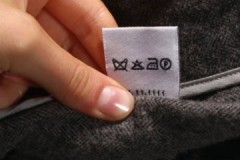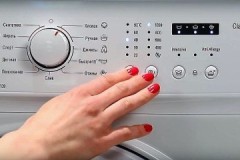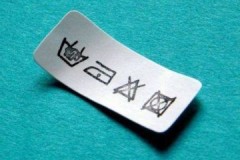Everything you wanted to know about dry washing, but were embarrassed to ask
 Some types of fabrics do not tolerate contact with water. To clean them, they resort to the dry washing method using improvised means or professional household chemicals.
Some types of fabrics do not tolerate contact with water. To clean them, they resort to the dry washing method using improvised means or professional household chemicals.
Read the article about what dry washing is, what means it is used for, and how to do it correctly at home.
Content
What it is?
Dry washing is a method of cleaning fabrics without using water. The advantage of this method is its safety.
Interestingly, this method was invented in 1849 in France, when one of the residents spilled turpentine on himself. However, contrary to his expectations, the thing did not get dirty, but was cleaned of dirt and stains.
Bulk materials are used as cleaning substances, including:
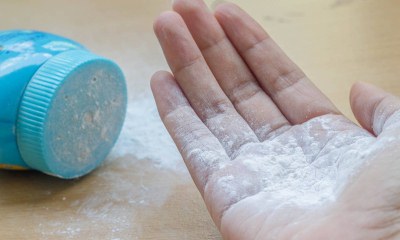 starch;
starch;- soda;
- talc;
- flour;
- sand;
- baby powder;
- sawdust, etc.
In addition, you can find professional household chemicals on sale intended for dry cleaning of fabrics. They absorb foreign odors, dust, dirt and grease well.
By mastering the dry washing method, you can significantly save on dry cleaning services.
When is it necessary?
They resort to dry washing if you need to clean such types of fabrics as:
To understand whether a product can be wetted, you need to read the information on its label. The Dry Clean Only icon will appear as a white circle. The tag may also contain the note “dry clean only”.
How to do it at home?
The procedure for dry washing depends on the detergent you choose. Each composition has its own recommendations, exposure time and application rules.
Soda
Baking soda is a budget-friendly product that allows you to efficiently clean dirt from an item, without water.
It is used in two ways:
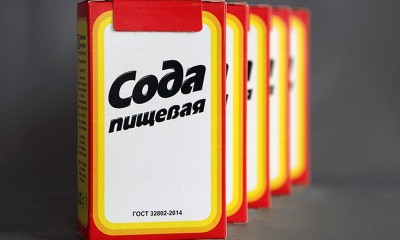 Mix 1 tsp. washing powder, 2 tsp. soda and apply to the fabric. If the product is resistant to acid treatment, then sprinkle it with a small amount of vinegar. Rub the composition with a brush and leave for 30 minutes. When the product dries, simply shake off the item. This recipe helps to cope with pigmented stains from wine, blood, tea, urine, coffee, etc.
Mix 1 tsp. washing powder, 2 tsp. soda and apply to the fabric. If the product is resistant to acid treatment, then sprinkle it with a small amount of vinegar. Rub the composition with a brush and leave for 30 minutes. When the product dries, simply shake off the item. This recipe helps to cope with pigmented stains from wine, blood, tea, urine, coffee, etc.- In its purest form. Apply baking soda to the stain and press with a napkin or palm. After 1-2 hours, brush it off with a brush. This cleaning method is used to refresh the item or remove traces of grease from it.
There is no need to rub soda into the fabric so that hard particles do not cause holes to appear. It is enough to simply crush the powder, or carefully remove the dirt with a soft-bristled brush.
Vinegar
Vinegar makes colors brighter, helps get rid of foreign odors.
Procedure:
- dilute 2 tbsp in 1 liter of water. l. vinegar;
- using a spray bottle, spray the composition onto the fabric;
- walk over the contaminated area with a soft brush;
- after 2 hours the item is vacuumed.
Bran
You can refresh clothes made of fine fabric or with embroidery using bran.
They are used as follows:
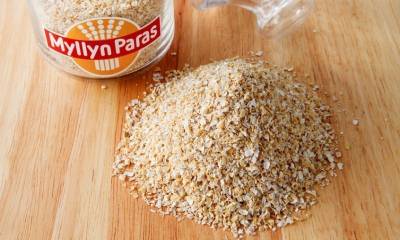 Soak the required amount of bran in a warm soapy solution.
Soak the required amount of bran in a warm soapy solution.- Drain the water through a sieve.
- The bran is applied to the item and gently rubbed with your hands, similar to washing.
- The wet product is shaken off.
- Repeat the cleansing using dry bran.
This method is suitable for removing dust and oily shine from dark items.
Sand
You can easily and efficiently clean fur using fine, clean sand.
Algorithm of actions:
- heat the sand in a dry frying pan or in the oven, but do not heat it;
- distribute it over the product that needs cleaning;
- leave for half an hour;
- remove sand with a brush.
Peroxide
Hydrogen peroxide helps lighten fabric and remove stains from it. It is used for white things. Dark colored items may have faded areas.
 Peroxide is used in 3 ways:
Peroxide is used in 3 ways:
- In its pure form, apply the composition to a cotton pad. Use it to wipe the stain until it disappears completely.
- Peroxide with lemon juice. They are diluted in equal proportions and rubbed into the problem area with your fingers.
- Peroxide with ammonia. The mixture is left until completely absorbed.
After completing the main cleaning procedure, wipe the fabric with a damp cloth.
Ammonia
Ammonia effectively removes oily shine and greasy stains. It is used in the following way:
- mix 4 tbsp. l. ammonia and 1 tbsp. l. table salt;
- the resulting slurry is applied to the contamination;
- when the mixture dries, remove its remains with a soft brush.
Starch
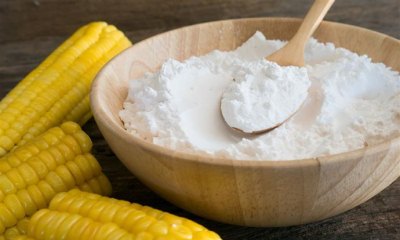 Corn starch is used to remove dust and greasy marks from light-colored clothing. Mode of application:
Corn starch is used to remove dust and greasy marks from light-colored clothing. Mode of application:
- Scatter starch over the surface that needs cleaning.
- Press it with a white paper napkin and leave it overnight.
- Remove starch by brushing it off.
If after the first cleaning the starch has darkened greatly, then the item was dusty. To ensure proper cleaning, the procedure must be repeated. Remains of the substance can be removed with a vacuum cleaner.
Starch is used to remove unpleasant odors, such as those from cigarette smoke.. To do this, the product is placed in a plastic bag, covered with starch and shaken thoroughly. Leave the item for 12 hours, after which you clean it in any convenient way.
Professional products
Dry washing can be done not only with improvised means, but also with professional household chemicals. The most effective compositions include:
- FAMACO dry cleaning spray. 250 ml of the product costs about 800 rubles. It is suitable for removing stains from suede, velor, and nubuck. The spray is intended for shoes, but it is actively used to remove various contaminants from clothes made of similar fabrics. The spray is sprayed, left for 15 minutes to dissolve the dirt, and then removed with a soft brush.
- Spray TUBA. It is suitable for cleaning any fabrics that have a durable color. Shake the bottle, distribute the foam over the surface to be treated and rub in with a brush. After 2 hours it is removed with a vacuum cleaner. The cost of a bottle weighing 360 g is 250 rubles.
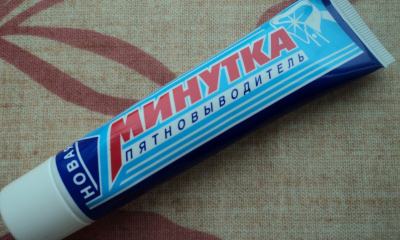 Gel Minutka. This product is used to remove stains from textiles, natural and synthetic fibers.A small amount of gel is applied in a thin layer to the contaminated area and lightly rubbed in. After drying, the powder is removed with a brush. The cost of a 44 ml tube is about 40 rubles.
Gel Minutka. This product is used to remove stains from textiles, natural and synthetic fibers.A small amount of gel is applied in a thin layer to the contaminated area and lightly rubbed in. After drying, the powder is removed with a brush. The cost of a 44 ml tube is about 40 rubles.- Shampoo for dry cleaning of textiles Carpet Dry Clean. The cost of 0.5 liter concentrate is 340 rubles. The product is diluted with water in a ratio of 1:20 and whipped into foam. It is applied to the surface of the product using a sponge or brush. After 3-5 minutes, the composition is removed with a vacuum cleaner along with the dirt.
- Foaming Clean by Hydrop. It is used to remove stains from textiles. Bottle volume – 150 ml. Its cost is 1150 rubles. The composition is consumed economically, since the foam is equipped with a dispenser. The kit includes a convenient brush. The foam is squeezed onto the surface to be cleaned, rubbed thoroughly and immediately removed with a napkin. One package is enough for about 100 cleanings.
You can purchase chemical fabric cleaners in household chemical stores and online markets.
How is it done in dry cleaning?
If you are unable to clean the product yourself, or there are concerns that it may be damaged, you need to contact a professional.. In dry cleaning, dry washing services are quite in demand. The laundry will help remove difficult stains, rid clothes of greasy shine, dust, and static electricity.
Before handing over the item, you need to clarify whether the dry cleaner will be able to achieve the result the client needs, and whether there is a risk that the fabric will be damaged.
Important information
To ensure that dry washing is not only effective, but also safe, The following tips should be taken into account:
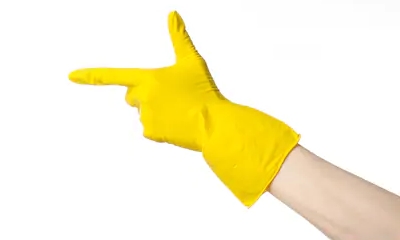 Test a new substance in an inconspicuous area. Even the most harmless cleaning products can cause damage to items.
Test a new substance in an inconspicuous area. Even the most harmless cleaning products can cause damage to items.- You need to work with gloves so as not to damage the skin of your hands when rubbing the item.
- To clean light-colored fabrics, white bulk substances (salt, soda, starch) are used. Dark matter is processed with sand or bran.
- You need to carefully remove abrasives from fabric. Residues from the cleaning agent may damage the product.
Conclusion
Dry cleaning involves using products that are not diluted with water. This method is quite effective and at the same time safe.
With its help you can refresh fabric, get rid of stains, restore color saturation. If you can’t cope on your own, you need to seek the help of professionals.
